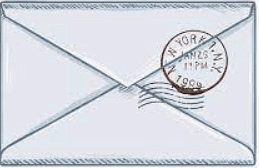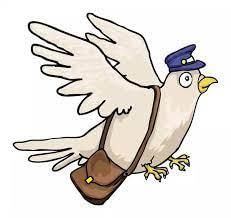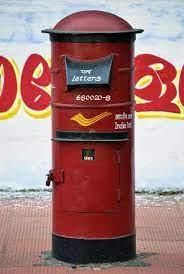Worksheet Solutions: Here Comes A Letter - 2 | EVS for Class 3 PDF Download
Q1: Multiple Choice Questions (MCQs).
(i) What is a form of communication between two people?
(a) Letter
(b) Game
(c) Stamp
(d) Postbox
Ans: (a)
A letter is a form of communication between two people where one person writes a message and sends it to the other person through the postal system.

(ii) What are some forms in which letters can be sent?
(a) Postcards, envelopes, inland letters
(b) Emails, SMS, WhatsApp
(c) Phone calls
(d) Games
Ans: (a)
Letters can be sent in various forms like postcards, envelopes, and inland letters.
(iii) How were letters sent in earlier days?
(a) Through a messenger or by pigeons
(b) Through email
(c) Through WhatsApp
(d) Through phone calls
Ans: (a)
In earlier days, letters were sent through a messenger or by pigeons.
(iv) What is the main topic of the passage "Here Comes A Letter"?
(a) The history of the postal service
(b) The journey of a letter
(c) Different types of communication
(d) The importance of telephone communication
Ans: (b)
The passage primarily discusses the journey of a letter from being written to reaching its destination.
(v) Which of the following is NOT mentioned as a means of communication in the passage?
(a) Postcards
(b) Inland letters
(c) Telefax
(d) Email
Ans: (c)
The passage mentions postcards, envelopes, and inland letters as forms of communication, but not telefax.
Q2: Fill in the Blanks.
(i) What happens to the letter after we drop it in the letterbox? After we drop a letter in a letterbox, it gets collected and taken to the ________.
Ans: post office
After we drop a letter in a letterbox, it gets collected and taken to the post office for further processing.
(ii) Who delivers the letters to us? The ________ delivers the letters to us by hand.
Ans: Postman
The Postman delivers the letters to us by hand.
(iii) What is the PIN code number used for in a letter? The PIN code number is written after the address on a letter to help it reach its destination ________.
Ans: fast
The PIN code number is written after the address on a letter to help it reach its destination faster.
(iv) To help letters reach their destination faster, people write the ______________ after the address.
Ans: PIN code number
The passage suggests that writing the PIN code number after the address helps in faster delivery of letters.
(v) Reena's letter started its journey in ______________, as indicated by the stamp on it.
Ans: Agartala
The passage mentions that the stamp on Reena's letter was from Agartala.
Q3: True or False.
(i) What has replaced letters nowadays for communication? Telephones have replaced letters nowadays for communication as they transmit messages very fast.
Ans: True
This statement is true. Telephones have largely replaced letters for communication due to their speed.
(ii) How do you make your own telephone with matchboxes or ice-cream cups? To make your own telephone with matchboxes or ice-cream cups, you need to make holes in them, thread a needle through both holes, and tie knots at both ends of the thread.
Ans: True
This statement is true. To make a simple homemade telephone, you indeed need to create holes in the containers, thread a needle through them, and tie knots at both ends of the thread.
(iii) Why was the letter stamped at the post office? The letter was stamped at the post office to make it look official.
Ans: False
This statement is false. The letter was stamped at the post office primarily to indicate the place of origin, not to make it look official.
(iv) Letters can be sent in various forms, including postcards, envelopes, and inland letters.
Ans: True
The passage mentions that letters can be sent in various forms.
(v) Letters used to be sent through messengers and pigeons in the past.
Ans: True
The passage states that in earlier days, letters were sent through messengers or by pigeons.
Q4: Answer the following Questions.
(i) Which letters have stamps on them?
Ans: All the letters have stamps on them.
(ii) Have you noticed the post office stamp on these letters?
Ans: Yes, I have.
(iii) What are different types of letters?
Ans: Some letters are postcards, some are envelopes, etc.
(iv) Are all the stamps similar? What are the differences?
Ans: No, all the stamps are not similar. They each have a different image and a different price listed on them.
(v) Reena’s letter reached Delhi by train. When there were no railways, how do you believe letters got to remote locations?
Ans: When there were no trains, letters used to be carried to distant places by people, pigeons, and horses.
(vi) With whom do you talk on the telephone?
Ans: I talk to my friends on the telephone.
(vii) Where have you seen telephones?
Ans: I have seen telephones at offices, houses, schools, colleges, telephone booths, etc.
|
62 videos|326 docs|48 tests
|
FAQs on Worksheet Solutions: Here Comes A Letter - 2 - EVS for Class 3
| 1. What is the article "Here Comes A Letter" about? |  |
| 2. How can letter writing benefit individuals? |  |
| 3. Are there any tips provided in the article for writing effective letters? |  |
| 4. Can letter writing be considered a dying art? |  |
| 5. How can letter writing be incorporated in today's digital age? |  |
















